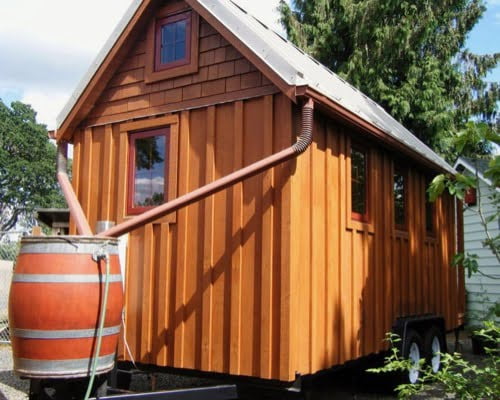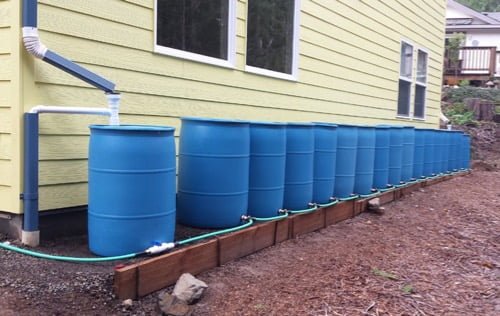 Image source: Alison Hancock/Shutterstock
Image source: Alison Hancock/Shutterstock
Turn off the taps and lower your water bill. It’s easy to use rainwater to irrigate your garden. Here are 3 steps to help you get an effective system set up. Once you’re using rainwater instead of groundwater to irrigate, you won’t need to run up your water bill for a green and thriving garden.
How much rainfall do you need to irrigate with rainwater?
Here in Asheville, N.C., we get an average rainfall of about 37 inches per year. But even in drier places, collecting rainwater can work. You’ll collect the rainwater from your roof, and the amount you can collect is dependent on the roof surface area and amount of rain. This means you could collect 1,500 gallons of water from 2 inches of rain on a 1,200 square foot roof.
It’s likely that there’s plenty of rainwater to irrigate your lawn and garden where you are. Check out this handy rainwater calculator to determine how much rainwater you can collect, based on the size of your roof and average rainfall.
Why use rainwater to irrigate?
Plants and flowers thrive when hydrated with oxygenated rainwater. Capturing this precious resource in a rain barrel is environmentally sound. There’s no need to use energy for pumping when you collect water from the sky. Additionally, rainwater needs somewhere to go, and collecting and using it for irrigation can reduce erosion, mud, and drainage issues. Finally, irrigating with rainwater instead of groundwater preserves the integrity of the water table.
Be aware: rainwater from roof surfaces does pick up bacteria from bird poop and other sources, as well as chemicals from roofing materials. Keep this in mind when watering fruits and vegetables, especially things like lettuce, herbs, and low-growing fruits. It’s worth testing your rainwater before deciding to use it for irrigation.
Even if your rainwater is safe for the garden, do not drink it! It will have too much bacteria for human consumption. Keep the lids secure to protect children and animals. During overly rainy times of the year, watch the containers for overflow.
To learn more about irrigation strategies, plus how to grow over 25 vegetables, berries, and herbs, check out our Online Gardening School.
Step 1: Gutters and Downspouts
You’ll need gutters to collect rainwater. When rainfall hits the roof of your house (or garage, shed, barn, tiny house etc.), it enters the gutter, which then leads to a downspout. Keep those access areas clean from leaves and debris. In fact, you might think about installing a gutter system that protects the lanes from getting clogged. Add a screen or filter at the end of the downspout to prevent debris from entering your barrel or tank.
Step 2: Rain Barrels
To use a rain barrel, drill a hole in the gutter spout to attach a trowel-like spigot. It will lead rainwater directly into the container. If possible, cover the spout to keep mosquitoes away.
A 55-gallon drum fills up rather quickly, so you’ll want to have a couple of large containers on hand for convenience. When you’re looking for the best rain barrel(s) to use, consider:
- A mesh screen on top to keep out leaves, shingle grit, debris, and mosquitoes.
- An overflow spigot that drains excess water.
- Placing the barrel on a pedestal of some kind so that gravity will help it to drain.
- Hoses that allow you to relieve a full barrel directly into your garden (or that send water to another barrel).
Step 3: Irrigating with stored rainwater
Irrigating your garden with rain barrel water is easy; you can use a watering can or a hose. In the case of a can, just remove the lid and dip it right in. To use a hose, you’ll need to have the barrel placed higher than the area you want to water, so gravity can move the water. You can even attach a drip irrigation system to your rain barrel, in which case all you need to do is flip a valve to water your garden or lawn.
Sprinkler systems require more pressure. So, if you want to use sprinklers, you may need to hook up a pump to your rain barrel.
Our favorite books about rainwater harvesting
Note: The links below are part of an Amazon affiliate program. When you click them, we benefit (at no cost to you). If you want to find these items locally, more power to you! If you’re going to buy them online, clicking-through here helps us continue offering free information and resources to everyone.
Rainwater Harvesting for Drylands and Beyond Volume 1: Guiding Principles to Welcome Rain into your Life by Brad Lancaster
Rainwater Harvesting for Drylands and Beyond Volume 2: Water Harvesting Earthworks by Brad Lancaster
This is a guest post from James Witts. He is an eco-conscious home improvement writer. He is constantly trying to find new ways to live off the grid while living in a tiny home with his wife, Andie.




